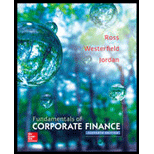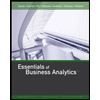
Fundamentals of Corporate Finance
11th Edition
ISBN: 9780077861704
Author: Stephen A. Ross Franco Modigliani Professor of Financial Economics Professor, Randolph W Westerfield Robert R. Dockson Deans Chair in Bus. Admin., Bradford D Jordan Professor
Publisher: McGraw-Hill Education
expand_more
expand_more
format_list_bulleted
Concept explainers
Textbook Question
Chapter 11, Problem 26QP
Operating Leverage and Taxes [LO4] Show that if we consider the effect of taxes, the degree of operating leverage can be written as:
Notice that this reduces to our previous result if T = 0. Can you interpret this in words?
Expert Solution & Answer
Want to see the full answer?
Check out a sample textbook solution
Students have asked these similar questions
Solve with explanation and financial accounting question
Please give me answer with financial accounting solution
I need help with financial accounting question
Chapter 11 Solutions
Fundamentals of Corporate Finance
Ch. 11.1 - Prob. 11.1ACQCh. 11.1 - What are some potential sources of value in a new...Ch. 11.2 - Prob. 11.2ACQCh. 11.2 - What are the drawbacks to the various types of...Ch. 11.3 - How are fixed costs similar to sunk costs?Ch. 11.3 - What is net income at the accounting break-even...Ch. 11.3 - Why might a financial manager be interested in the...Ch. 11.4 - If a project breaks even on an accounting basis,...Ch. 11.4 - If a project breaks even on a cash basis, what is...Ch. 11.4 - Prob. 11.4CCQ
Ch. 11.5 - What is operating leverage?Ch. 11.5 - How is operating leverage measured?Ch. 11.5 - Prob. 11.5CCQCh. 11.6 - What is capital rationing? What types are there?Ch. 11.6 - Prob. 11.6BCQCh. 11 - Prob. 11.1CTFCh. 11 - Marcos Entertainment expects to sell 84,000...Ch. 11 - Delta Tool has projected sales of 8,500 units at a...Ch. 11 - What is true for a project if that project is...Ch. 11 - A capital-intensive project is one that has a...Ch. 11 - Pavloki, Inc., has three proposed projects with...Ch. 11 - Forecasting Risk [LO1] What is forecasting risk?...Ch. 11 - Sensitivity Analysis and Scenario Analysis [LO1,...Ch. 11 - Prob. 3CRCTCh. 11 - Operating Leverage [LO4] At one time at least,...Ch. 11 - Operating Leverage [LO4] Airlines offer an example...Ch. 11 - Prob. 6CRCTCh. 11 - Prob. 7CRCTCh. 11 - Prob. 8CRCTCh. 11 - Prob. 9CRCTCh. 11 - Scenario Analysis [LO2] You are at work when a...Ch. 11 - Calculating Costs and Break-Even [LO3] Night...Ch. 11 - Prob. 2QPCh. 11 - Scenario Analysis [LO2] Sloan Transmissions, Inc.,...Ch. 11 - Sensitivity Analysis [LO1] For the company in the...Ch. 11 - Sensitivity Analysis and Break-Even [LO1, 3] We...Ch. 11 - Prob. 6QPCh. 11 - Prob. 7QPCh. 11 - Calculating Break-Even [LO3] In each of the...Ch. 11 - Calculating Break-Even [LO3] A project has the...Ch. 11 - Using Break-Even Analysis [LO3] Consider a project...Ch. 11 - Calculating Operating Leverage [LO4] At an output...Ch. 11 - Leverage [LO4] In the previous problem, suppose...Ch. 11 - Operating Cash Flow and Leverage [LO4] A proposed...Ch. 11 - Cash Flow and Leverage [LO4] At an output level of...Ch. 11 - Prob. 15QPCh. 11 - Prob. 16QPCh. 11 - Sensitivity Analysis [LO1] Consider a four-year...Ch. 11 - Operating Leverage [LO4] In the previous problem,...Ch. 11 - Project Analysis [LO1, 2, 3, 4] You are...Ch. 11 - Project Analysis [LO1, 2] McGilla Golf has decided...Ch. 11 - Prob. 21QPCh. 11 - Sensitivity Analysis [LO1] McGilla Golf would like...Ch. 11 - Break-Even Analysis [LO3] Hybrid cars are touted...Ch. 11 - Break-Even Analysis [LO3] In an effort to capture...Ch. 11 - Prob. 25QPCh. 11 - Operating Leverage and Taxes [LO4] Show that if we...Ch. 11 - Scenario Analysis [LO2] Consider a project to...Ch. 11 - Sensitivity Analysis [LO1] In Problem 27, suppose...Ch. 11 - Prob. 29QPCh. 11 - Prob. 30QP
Knowledge Booster
Learn more about
Need a deep-dive on the concept behind this application? Look no further. Learn more about this topic, finance and related others by exploring similar questions and additional content below.Similar questions
- Need help with the Correct answer of this Financial Accounting Questionarrow_forward: A project costs $100,000 and is expected to generate cash flows of $30,000 annually for 5 years. If the discount rate is 8%, should the project be accepted based on Net Present Value (NPV)?arrow_forwardYou are considering a project in Poland, which has an initial cost of 250,000PLN. The project is expected to return a one-time payment of 400,000PLN 5 years from now. The risk-free rate of return is 3% in Canada and 4% in Poland. The inflation rate is 2% in Canada and 5% in Poland. Currently, you can buy 375PLN for $100. How much will the payment 5 years from now be worth in dollars? Question 6 options: $1,576,515 $1,489,025 $101,490 $1,462,350 $142,060arrow_forward
- : A project costs $100,000 and is expected to generate cash flows of $30,000 annually for 5 years. If the discount rate is 8%, should the project be accepted based on Net Present Value (NPV)? i need hellarrow_forwardYou invest 60% of your money in Asset A (expected return = 8%, standard deviation = 12%) and 40% in Asset B (expected return = 5%, standard deviation = 8%). The correlation coefficient between the two assets is 0.3. What is the expected return and standard deviation of the portfolio? helparrow_forwardImporters and exporters are key players in the foreign exchange market. Question 10 options: True Falsearrow_forward
- Triangle arbitrage helps keep the currency market in equilibrium. Question 9 options: True Falsearrow_forwardThe use of dividends is a method by which a foreign subsidiary can remit cash to its parent company. Question 8 options: True False\arrow_forwardThe notion that exchange rates adjust to keep the purchasing power of a currency constant across countries is called: Question 7 options: Interest rate parity. The unbiased forward rates condition. Uncovered interest rate parity. Purchasing power parity. The international Fisher effect.arrow_forward
- The notion that exchange rates adjust to keep the purchasing power of a currency constant across countries is called: Question 7 options: Interest rate parity. The unbiased forward rates condition. Uncovered interest rate parity. Purchasing power parity. The international Fisher effect.arrow_forwardSuppose the direct exchange rate for the Canadian dollar and U.S. dollar is 1.11, this means that you can buy $1 U.S. for $1.11 Canadian. Question 5 options: True Falsearrow_forwardThe 60-day forward rate for Japanese Yen is x108.02 per $1. The spot rate is x103.09 per $1. In 60 days you expect to receive x1,500,000. If you agree to a forward contract, how many dollars will you receive in 60 days? Question 4 options: $154.635 million $15,312 million $13,886 million $14,550 millionarrow_forward
arrow_back_ios
SEE MORE QUESTIONS
arrow_forward_ios
Recommended textbooks for you
 Intermediate Financial Management (MindTap Course...FinanceISBN:9781337395083Author:Eugene F. Brigham, Phillip R. DavesPublisher:Cengage Learning
Intermediate Financial Management (MindTap Course...FinanceISBN:9781337395083Author:Eugene F. Brigham, Phillip R. DavesPublisher:Cengage Learning Essentials of Business Analytics (MindTap Course ...StatisticsISBN:9781305627734Author:Jeffrey D. Camm, James J. Cochran, Michael J. Fry, Jeffrey W. Ohlmann, David R. AndersonPublisher:Cengage Learning
Essentials of Business Analytics (MindTap Course ...StatisticsISBN:9781305627734Author:Jeffrey D. Camm, James J. Cochran, Michael J. Fry, Jeffrey W. Ohlmann, David R. AndersonPublisher:Cengage Learning

Intermediate Financial Management (MindTap Course...
Finance
ISBN:9781337395083
Author:Eugene F. Brigham, Phillip R. Daves
Publisher:Cengage Learning

Essentials of Business Analytics (MindTap Course ...
Statistics
ISBN:9781305627734
Author:Jeffrey D. Camm, James J. Cochran, Michael J. Fry, Jeffrey W. Ohlmann, David R. Anderson
Publisher:Cengage Learning
Working capital explained; Author: The Finance Storyteller;https://www.youtube.com/watch?v=XvHAlui-Bno;License: Standard Youtube License